
Have you ever spotted tiny, white, and winged insects that appear to have settled on the leaves of your plants? These gradually increase in number, covering large underside areas of both young and old foliage. Allowing these to colonize the plant can significantly weaken the shoots and prevent the production of blooms and fruits. Generally called whiteflies, these pests spell bad news and should be dealt with in a timely manner.
Whiteflies are related to aphids and mealybugs, with which they are often misidentified. They are not considered true flies despite their possession of wings. Instead, they belong to the order Hemiptera. These insects are most commonly found in warm regions as their eggs are unable to hatch in the cold. They also tend to infest plants in greenhouses and in other indoor locations. Colonies are usually spotted during the warmest and most humid days of the year.
Many vegetables, trees, and tropical houseplants are markedly susceptible to whitefly infestations. As they feed on sap and produce honeydew in the process, they eventually promote fungal growth. The symptoms of infestations can be irreversible and may lead to plant death. Fortunately, there are some hardy plants that can be used to repel these nasty pests and keep their numbers at bay!
1) Catnip (Nepeta cataria)

Named for its natural ability to attract cats and stimulate their senses, catnip is a fragrant herb with sedative properties. For a perennial, it is fairly short-lived yet produces shoots that can measure as much as 40 inches (102 cm) tall. Its tiny blooms appear throughout a lengthy flowering period that lasts from spring to fall. White to soft pink in color, these occur in dense and fragrant inflorescences.
The scented leaves of catnip contain nepetalactone, a terpenoid with insect repellent properties. Studies have shown that this compound, when rubbed onto the fur of cats, helps keep them free of mosquitoes. The plant’s essential oils have also shown potential for use against larger insects like termites and cockroaches. Thus, stands that are dense enough to emit their distinct fragrance, especially when some of the leaves are cut, can keep hungry whiteflies away.
Hardy to USDA zones 3 – 9, catnip should be planted in fully sunlit areas of the garden. Its roots become quickly established in fertile, well-draining substrates. It can also be grown indoors, next to leafy plants that are often plagued by pests.
2) Basil (Ocimum basilicum)
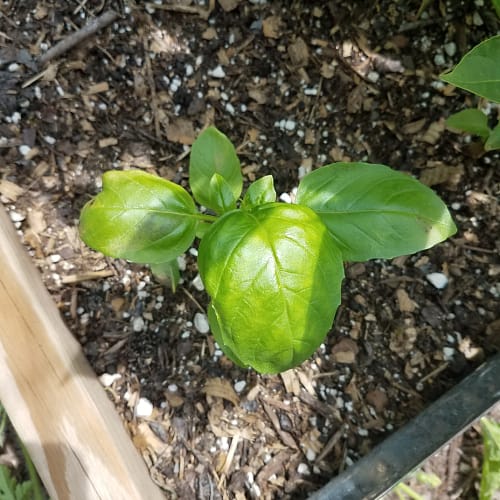
One of the most popular herbs to grace our gardens and kitchens, basil is a fragrant plant that comes in many cultivars and hybrids. With slightly different flavors and scents, these are largely distinguished by their leaf morphology. The global demand for basil has led to its industrial-level cultivation in many warm regions across the globe. Apart from imparting its flavors to tasty dishes, it is also the source of important compounds in folk medicine and in studies of natural insect repellents.
Basil essential oil has shown potential as a natural insecticide, nematicide, and fungicide. Healthy specimens, when present in considerable densities, can keep many flies and scent-sensitive pests away from the garden. The scent and toxic properties of the oil are, of course, magnified when the leaves of the plant are mechanically damaged.
As basil can be planted alongside many vegetables, it can’t hurt to grow this herb around species that are frequently infested with whiteflies. By placing a few pots around tomatoes, for example, the growth of more fruits should be promoted via the protection of tomato leaves. If the basil is effective at keeping pests away, the use of chemical pesticides may be reduced significantly.
3) Lavender (Lavandula spp.)
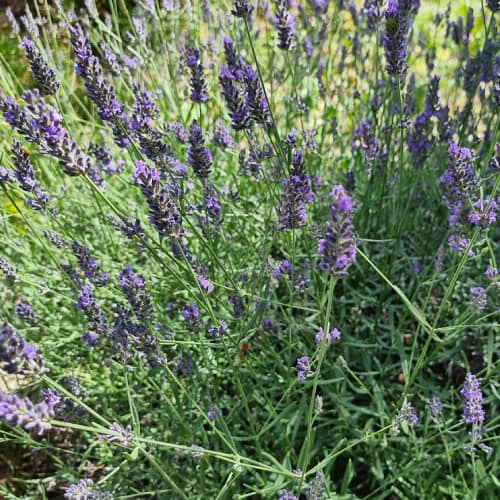
The source of a fragrance that can lull humans to sleep by calming mental unrest, lavender is a wondrous plant with many uses. Its essential oils are a staple in the perfume industry, while its buds and blooms have culinary uses. Lavandula species are important for biodiversity due to their attractiveness to pollinators. With a wide array of phytochemicals, these plants’ applications in herbalism are matched by a rich historical background.
As a natural insecticide, lavender is most effective in the form of its pure extracts. Whiteflies dislike the strong scent of the plant’s oils and will likely settle on other species that are a safe distance away. Intact leaves may, to an extent or if they are found in dense stands, repel these pests and many of their closest relatives. Lavender’s preference for arid substrates and full sun, however, limits its potential in indoor and humid areas where whitefly infestations tend to occur.
Regardless, you can definitely use lavender cuttings or its extracted oils to protect plants that are situated in greenhouses and in the shade of your home. An oil-based spray, mixed with water and witch hazel, should be safe for use as an eco-friendly insecticide in the household and on crops grown for human consumption.
4) Dill (Anethum graveolens)

The only species in its genus, A. graveolens is a fine herb with a unique flavor profile. Its tangy taste sets many European and Russian dishes apart. The threadlike leaves are often finely chopped and incorporated into soups, creams, and mixtures for pickling vegetables. Its strong scent can easily be identified by anyone with a sharp nose. You can be certain that scent-sensitive insects would likewise be affected, albeit negatively, by this plant.
Dill oil, which is found throughout the roots and shoots, contains carvone, limonene, and dillapiole. These volatile compounds have collectively shown potential as ingredients in plant-based pesticides. When used in large doses, the essential oil should definitely repel whiteflies. If it is strong enough to aid in the preservation of pickles and appeal to an acquired taste, it’s strong enough to keep most insects away!
Dill can be planted close to herbs that are susceptible to aphids, squash bugs, spider mites, whiteflies, and more. Thick stands of mature plants would, of course, be most effective at repelling pests as their fragrance will need to be concentrated enough to waft through a section of the garden.
5) French marigold (Tagetes spp.)

Extremely popular as an ornamental plant due to its vividly colored blooms and ease of care, the French marigold is a lovely annual for tropical to subtropical gardens. It can be cultivated in substrates with ample drainage and a moderate to rich nutrient profile. Healthy shoots can quickly grow up to half a meter (1.6 feet) tall when provided with full sun and good ventilation.
Marigold blooms appear in summer and may persist until fall in warm climates. The floral heads attract a wealth of beneficial insects (e.g. ladybugs, hoverflies), many of which feed on pests like aphids and whiteflies. The leaves of the plant contain pungent oils, which, alongside secretions of the roots, may repel all sorts of pests. Thus, this species can be used as a companion plant for more vulnerable vegetables, such as tomatoes.
Note, however, that marigolds can also attract insects that may feed on starch-rich crops, like potatoes. It’s best to closely observe its effect on your companion plants so that any unintended outcomes can be dealt with at the early stages of growth.
6) Bee balm (Monarda spp.)
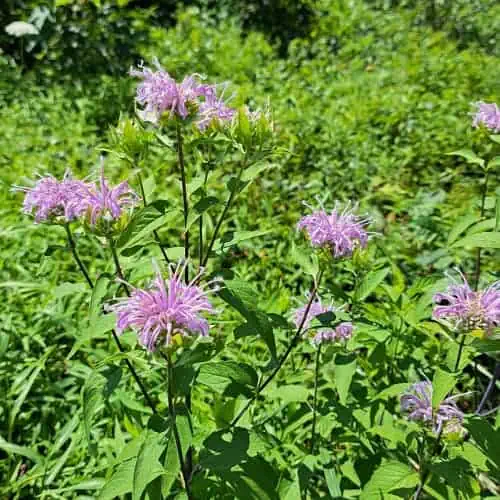
Both annual and perennial species listed under the Monarda genus are commonly referred to as bee balm, horsemint, or bergamot. The fragrance emitted by their leaves is similar to that of the bergamot orange (Citrus bergamia), which is likewise known for repelling pests. The essential oils extracted from the leaves are said to be quite spicy and bitter. Based on Native American history, these have herbal uses for the treatment of both skin and internal conditions.
Bee balm leaves must be crushed to be effective at repelling pests. While the scent of bee balm may be enough to keep whiteflies away, it’s the plant’s capacity to attract beneficial insects that deserves our attention. Bee balm flowers, which are vividly pink to red in color, draw in natural aphid, mealybug, and whitefly predators. These insects, largely represented by pirate bugs, hoverflies, and beneficial mites, can slowly help deplete whitefly populations and eggs on nearby plants.
Many Monarda cultivars are popular due to the fantastic colors they add to sunny gardens. These include ‘Balmy Pink’, ‘Beauty of Cobham’, ‘Raspberry Wine’, and ‘Squaw’ (an RHS Award of Garden Merit recipient). Grow these alongside one another and next to beds of vulnerable plants to increase your garden’s diversity of pest-eating bugs.
7) Chives (Allium schoenoprasum)

Often mistaken for its closest cousins, the most popular of which are scallions and green onions, A. schoenoprasum is a fantastic herb in its own right. Commonly known as chives, this culinary ingredient can be used in its raw or cooked form. Its taste and fragrance are strong enough to infuse through complex dishes even if just a small amount of the leaves is used as a garnish.
Chives are fairly widespread throughout their native range. Both the leaves and blooms work together to keep pests away. The blooms attract beneficial, pest-eating insects, while the juices of the leaves are repulsive to pests due to their sulfur-based compounds. As whiteflies feed on sap, they are unlikely to produce colonies on the foliage of chives.
The lemon-scented essential oil of chives is also incorporated into commercial insect repellents such as candles and mosquito coils. Maintaining at least a small colony of this plant should help alleviate mild pest problems. As a bonus, you’ll have fresh leaves to add delectable color, fragrance, and taste to your homemade dishes!
8) Nasturtium (Tropaeolum spp.)
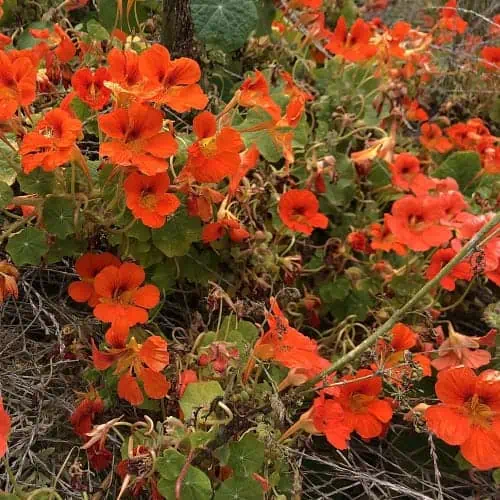
Known for their circular leaves and showy blooms, nasturtiums come in about 80 perennial and annual species. Their common name is derived from the similarity of their oils to that of watercress (of the genus Nasturtium). These oils repel a wide variety of pests, allowing these plants to serve as great companions for more vulnerable herbs. The vividly-colored blooms also attract many predatory insects, which can help decimate whitefly populations in your garden.
Eye-catching plants, the most popular nasturtiums in cultivation include T. majus, T. speciosum, and T. peregrinum. These now come in countless cultivars and hybrids, many of which can add cheery color to fully sunlit locations with well-draining substrates. Once established, they require minimal maintenance; they favor relatively poor soils and have moderate water needs.
Squash, melon, cucumber, and other Cucurbita species typically thrive when they are planted next to a variety of nasturtiums. Apart from repelling whiteflies, nasturtiums can help save a crop from the appetites of squash bugs and cucumber beetles.
9) Wormwood (Artemisia absinthium)

An ornamental plant with a reputation for being dangerous, wormwood is the quintessential addition to every poison garden. It contains a potent type of thujone, a phytochemical that can cause seizures and death in large doses. This plant’s sap is the last thing a whitefly, or any other animal, would want to feast on.
Absinthe, a spirit with an equally infamous reputation, contains extracts from wormwood flowers and leaves. Before its thujone levels were regulated, it was once considered an illegal beverage due to the dangers of its overconsumption. When ingested by humans in moderate amounts, the thujone in wormwood is not necessarily linked to toxic side effects. It can definitely be toxic to smaller animals, however.
Fleas, lice, mites, and other small insects are repelled by wormwood cuttings. These can be spread around a small area to temporarily keep troublesome pests away. Wormwood can also be used as a companion plant for repelling fungi, aphids, and other close relatives of the whitefly.
10) Garden thyme (Thymus vulgaris)

Like basil, thyme is a fragrant culinary herb that is used in a wide range of dishes. The strong flavors of its freshly harvested leaves are imparted by a complex combination of phytochemicals. These same compounds help protect the plant from opportunistic pests in the wild.
Compared to the oils of garlic and cumin, which likewise contain insecticidal compounds, thyme oil has been shown to be remarkably effective against the sweet potato whitefly (Bemisia tabaci). The essential oil of T. vulgaris can also function as a natural mosquito repellent, highlighting the species’ potential as a source of compounds for plant-based insecticides.
For thyme to be effective against pests in the garden, its leaves will need to be bruised or finely chopped and spread. The fragrance of the oils must be released into the air to serve as a signal that should ward off incoming pests. If you’re able to acquire your own bottle, the essential oil itself can be lightly spread around the pots of vulnerable plants.
11) Epazote (Dysphania ambrosioides)
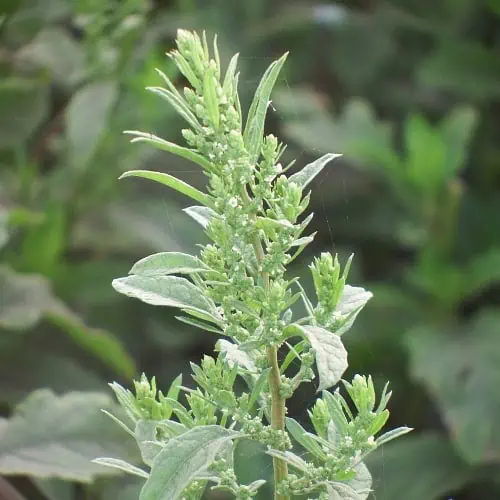
Grown in warm regions of the US and Europe, where escaped colonies may arise as weeds, epazote is a short-lived herb with both culinary and agricultural uses. Also commonly referred to as Mexican tea or Jesuit’s tea, this short-lived perennial produces a variety of terpenoid compounds. Some of these can act as natural pesticides and can be toxic to humans when consumed in large doses.
Some of the phytochemicals in epazote can inhibit the growth of nearby plants, but they do have the potential to protect vulnerable species by masking their scents from whiteflies and other pests. In the form of an essential oil, the compounds in this species are, to an extent, even more effective as an insecticide against whiteflies than those in neem oil and endosulfan. Their effects are comparable to those of insecticidal soap.
Epazote is distinguished by irregularly branched shoots and pungent, lance-shaped leaves. Its flowers are produced at the tips of fertile stems, which can grow to about 4 feet (1.2 meters) tall in optimal conditions. Tiny and somewhat unremarkable in terms of their appearance, the flowers may also attract beneficial insects.
12) Peppermint (Mentha x piperita)

A hybrid between two common mint species (M. aquatica and M. spicata), peppermint is a wonderful herb with enormous potential in the culinary and pharmaceutical industries. It thrives close to water features that consistently moisten bordering substrates. Given ample moisture, the roots can quickly spread via a network of underground rhizomes.
If you find that your pondside plants are frequently being plagued by whiteflies and other tiny pests, you would do well to cultivate a few stands of peppermint in between the most vulnerable species. If you’re worried about this hybrid’s capacity to spread, simply restrict its roots to within pots or containers. The intact leaves naturally give off a mild scent; you may bruise them or spray pure extracts of their essential oils to ward off insects.
Among mint oils, peppermint oil is considered a holy grail of natural, insecticidal and antimicrobial compounds. It can be sprayed around the pots of indoor plants that are frequently visited by pests. It can even be added to a mixture for use in a diffuser. This way, you can neutralize indoor scents while keeping cockroaches, spiders, ants, and small rodents away.

